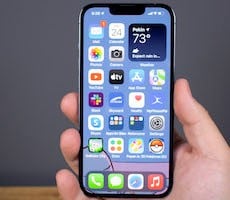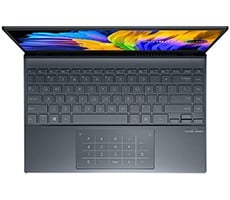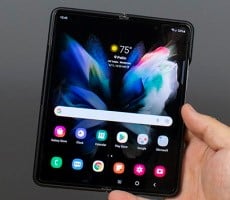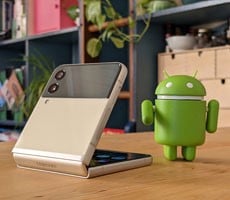iPhone 13 Pro Review: Fast, Impressive But Unfinished
The Apple iPhone 13 Pro throws a wrinkle into our benchmarking plans. Some of our favorite tests are just plain not available on iOS: AnTuTu and PCMark Work are Android-only benchmark suites. Only the newer AnTuTu 9 is available on iOS, and we just don't have data for comparison yet. Still, we have Geekbench 5, 3DMark, and GFXBench available, and we've added in some web tests to round out the group. Even in the graphics tests there are differences; 3DMark and GFXBench use Apple's Metal API whereas Android gets a mix of Vulkan and OpenGL ES. That doesn't particularly bother us because the same is true of games and other 3D apps on both platforms, so these tests are likely indicative of real-world performance.
As always, we run all of our benchmarks a minimum of three times and report the median result. All other background apps were closed so that no other tasks could steal precious cycles from the processor, and each benchmark was run off the charger since that's how we use our phones.
Apple iPhone 13 Pro Performance
Geekbench is a staple of all of our reviews. This cross-platform synthetic test puts the phone through a series of CPU-intensive tasks that mirror real-world workloads like photo editing and AI acceleration.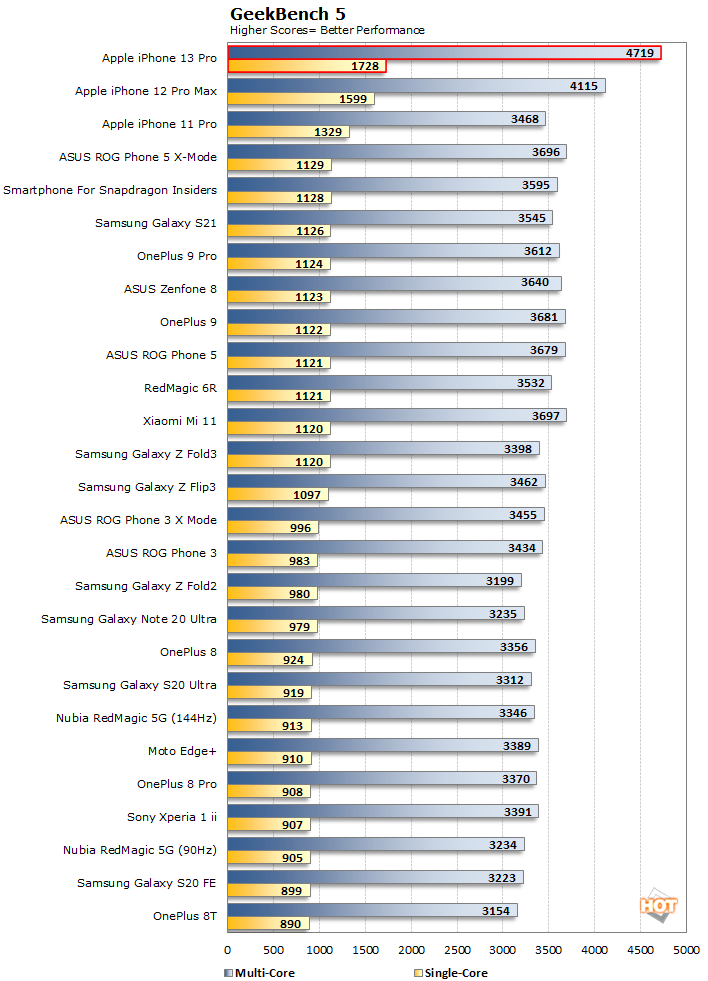
Apple's single-threaded performance has always been excellent, and that doesn't change here. While many of our Android devices have eight-way processors with four performance cores, the sheer grunt of the two performance cores in the A15 Bionic is enough to power the iPhone 13 Pro to a sizeable victory, even in the multi-core test. This will likely come in to play later on, too, so we'll keep watch.
Without PCMark available, we turned to the web for some productivity tasks. It doesn't matter if it's running a website in a browser or wrapping HTML and JavaScript content in a wrapper like Ionic and Electron, web content is everywhere including app stores. How a phone runs HTML and JavaScript with its default browser is important because that same system web engine powers those wrapped apps, too.
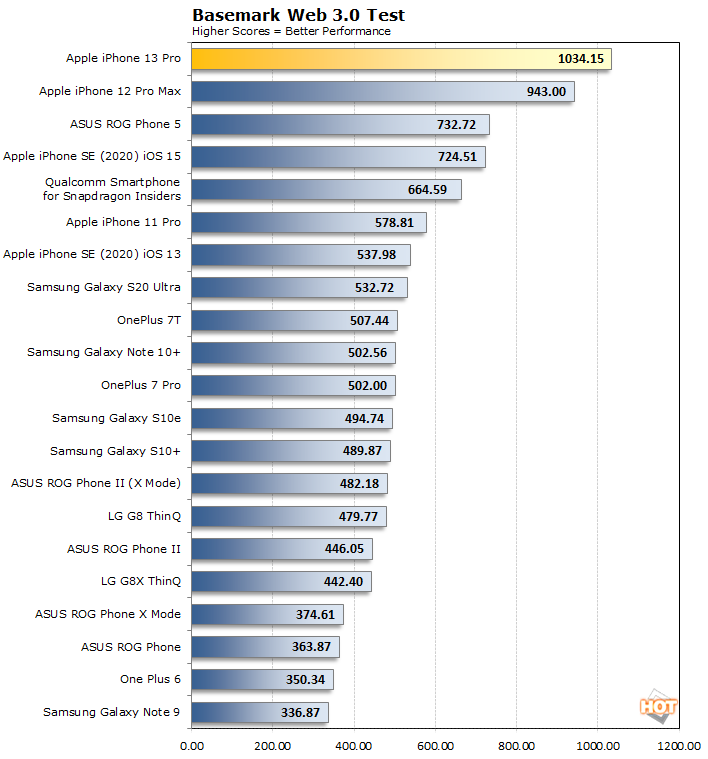
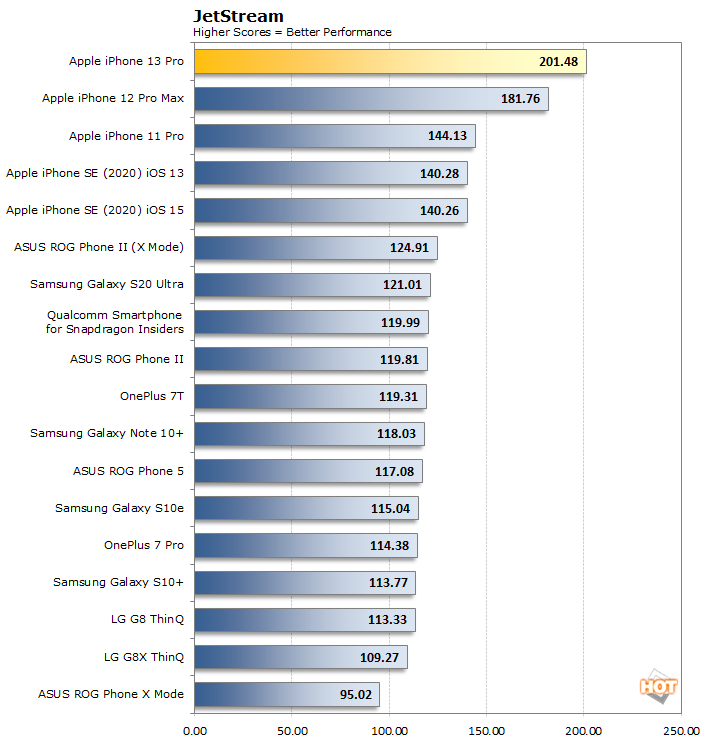
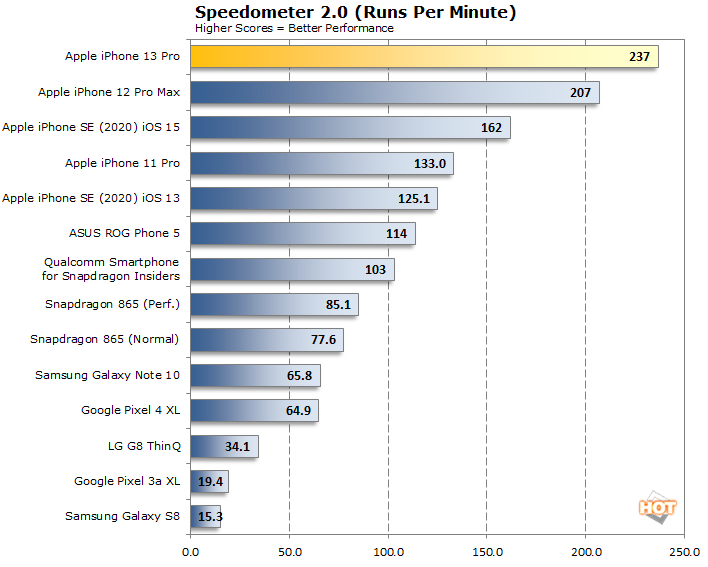
Our trio of web benchmarks show off some interesting trends. First of all, the iPhone 13 Pro just kills it in every test. Speedometer, which relies on DOM manipulation with sample web apps as much as raw compute, is especially strong for Apple's latest phone, more than doubling up every Android device on the list. The question then becomes why, and the answer seems to be as much software as it is hardware.
The iPhone's single-threaded performance is great, to be sure, but look at the 2020 iPhone SE, which appears on our list twice. Software alone made it nearly 30% faster. Apple boasted about vastly improved performance in Safari with the debut of iOS 14 and macOS 11 Big Sur last year. That seems to be driving a good chunk of performance, as the difference between Safari on iOS 13 and iOS 15 in our results data is huge.
GFXBench is a well-known and popular benchmark with a variety of scenes that can run with a whole host of graphics APIs. We used the T-Rex and Manhattan tests with OpenGL ES on Android phones, though we didn't get much choice on iOS; those tests all use Apple's Metal API.
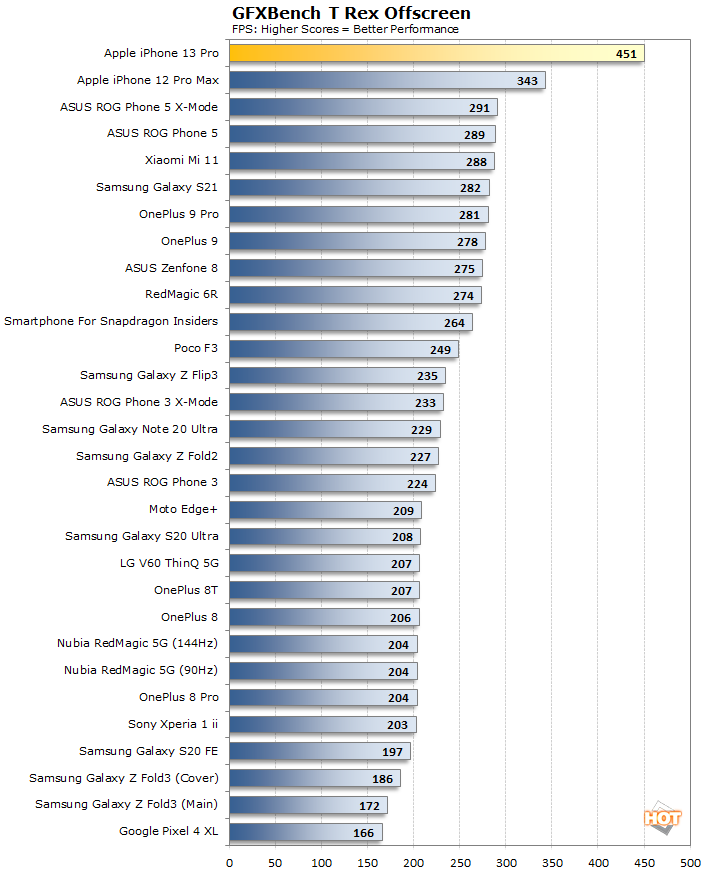
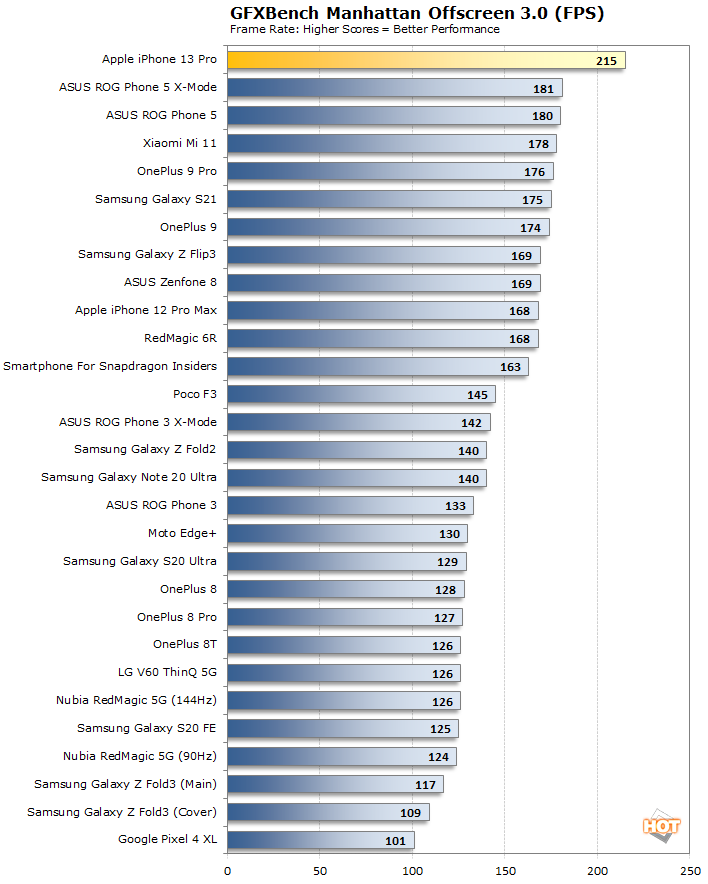
Again, the iPhone 13 Pro gets a pretty large win in this 3D GPU-focused test. Android flagship phones had basically caught up to Apple's GPU performance with the advent of Qualcomm's Snapdragon 888, as the OnePlus 9 and several other phones surpassed the iPhone 12 Pro in the heavier Manhattan test. The extra graphics resources put Apple back in the driver's seat, however, and it wins by nearly 20% over the next-fastest competitor in Manhattan. The T-Rex test is lighter on each device overall, giving way to some truly insane frame rates, and the iPhone 13 Pro is more like 55% faster than SD888 Android devices.

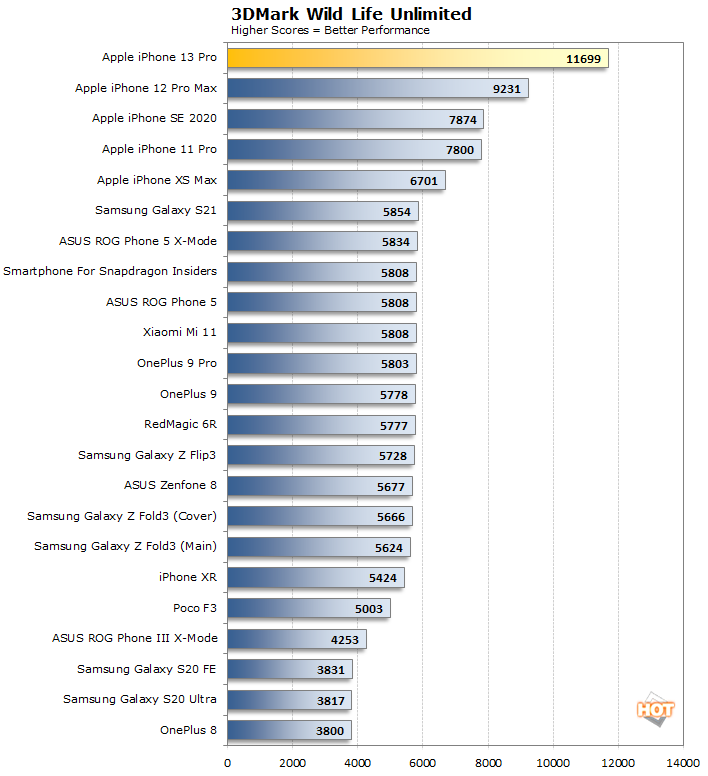
Meanwhile, Wild Life Extreme has always run well on iPhones since its inception, and right now Apple has a whopping 100% lead over Snapdragon 888 phones in this test. That seems pretty crazy, but at the same time, we know that modern phones are very similar to desktop and notebook hardware that hit a big burst of performance up front only to slow down over time in order to manage thermal and power constraints. Wild Life Extreme has a stress test which will show performance over time. How does it look?
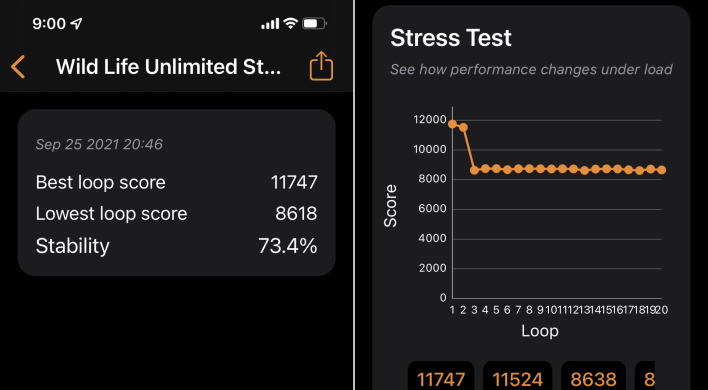
Well, this is interesting. After the second run, the iPhone 13 Pro sheds a pretty sizable 26% of its performance, but then it holds steady for a total of 16 runs at around 8600. That's still around 54% faster than all of the Snapdragon 888 phones on our charts. In other words, under total duress, the iPhone 13 Pro is still half-again faster than all any Snapdragon 888 phones that got to sit and cool down before running the test. If we go back to the Samsung Galaxy S21 5G review, we can see that phone also dropped a sizable chunk of its performance and bottomed out at 3,228. Of course, Wild Life isn't a game, but I think we can put the tired "iPhone tanks under load" argument to bed.
Battery Life and Charging
Ah, battery life. A phone is only as good as its battery life, because a phone with a drained battery is worthless when you need it. The trouble with quantifying battery life is that PCMark Work is just not available on iOS. As such, we don't really have any good way to compare concrete iOS numbers with any other phones, which is a shame. Unfortunately, we have to go with guts instead of hard numbers. The good news is that our gut tells us the iPhone 13 Pro has good battery life.The iPhone 13 Pro has a 3,095 mAh battery, which is around 25% smaller than many Android phones. For example, the Galaxy S21 and the Smartphone for Snapdragon Insiders produced by Asus both have 4,000 mAh batteries. That might imply that the iPhone has 25% less battery life than its Qualcomm-toting Android competition, but the difference in platforms makes it hazy, and so do the screen sizes for each. The Galaxy S21 has a 6.2" display while the Smartphone for Snapdragon Insiders has a whopping 6.78" display. So that means divining battery life based on capacity gets pretty fuzzy.
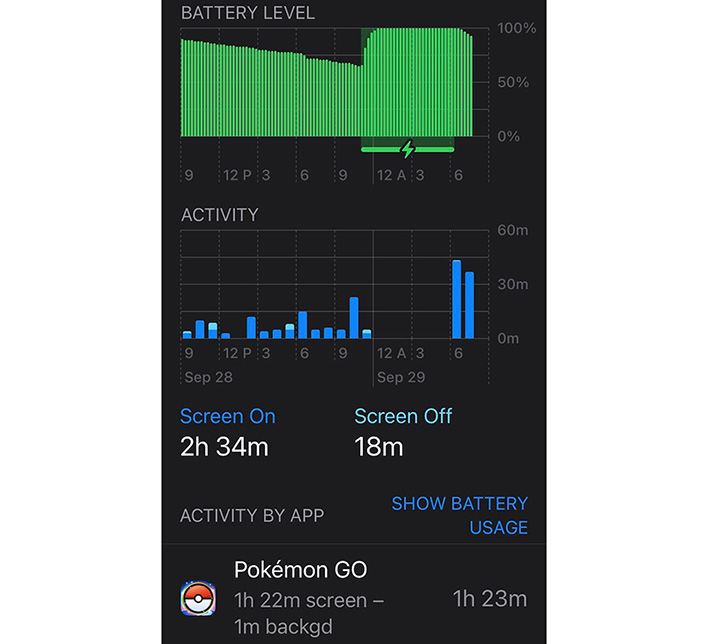
All that is to say the iPhone 13 Pro gets us through the day with a mix of some games, regular communication, and automatic display brightness. At bedtime, the battery level is still up over 50%. I could maybe squeeze two days out of it, depending on how long it sat overnight, but most smartphone users charge overnight. The same can be said of any Android smartphone I've used, including the recently-reviewed Samsung Galaxy Z Fold3, so the battery life is solid.
Speaking of charging overnight, Apple included fast charging support for up to 20 Watt chargers using the USB Power Delivery specification. Unfortunately, it's still saddled with a Lightning port instead of a USB-C connector. Apple also no longer ships iPhones with a charger, a move on which Samsung and others have followed suit, but does include a USB-C to Lightning cable in the box. That's cute, since Apple never shipped an iPhone with a USB-C charger, so most users are going to have to buy one. Mac and some PC laptop owners can use the Thunderbolt or USB-C ports on their machines, though. For those who prefer wireless charging, the iPhone 13 Pro supports the updated MagSafe style wireless chargers, as well the Qi wireless charging standard.
Next up, let's take a look at that much-ballyhooed camera...


